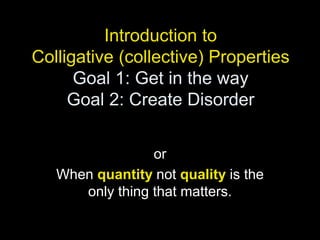
colligative intro.pptx
- 1. Introduction to Colligative (collective) Properties Goal 1: Get in the way Goal 2: Create Disorder or When quantity not quality is the only thing that matters.
- 2. An ice storm is coming. Your car’s radiator has no antifreeze in it; all stores are closed, and you’ve got to use whatever you have around the house to save your car’s engine. Also remember the motto for Colligative Properties Getting in the way is Good, Creating Disorder is Better It would be ideal to have antifreeze (ethylene glycol) but remember it’s quantity not quality that counts here.
- 3. The next morning you wonder if what you did saved you thousands of dollars on a new engine. Rule one: What you add has to dissolve in water. Rule two: If you add a solid that dissolves in water, it doesn’t matter what it is, just the amount. Rule three: Just like antifreeze, your goal is to replace about ½ of the water with a solid or liquid that is miscible with water. Examples 1: Sugar, salt, baking soda, shampoo, laundry detergent, pancake syrup. Examples 2: Rubbing alcohol, brake fluid
- 4. Again, it seems odd that the chemical nature of these different compounds are not a factor in regards to how much they depress the freezing point. Examples 1: Sugar, salt, baking soda, shampoo, laundry detergent, pancake syrup. It reminds us of the ideal gas law: PV=nRT The properties are not affected by what kind of gas we are talking about (at least in situations where they are behaving as an ideal gas).
- 5. How does it work? 1)Get in the way. 2)Create Disorder Reason 1: As the water tries to freeze, the other molecules get in the way. Reason 2: By adding these other substances, you’ve added disorder to the mixture. Nature tends to favor disorder (entropy). When water tries to freeze, it has to get organized, which will take more energy. Freezing point depression
- 6. This frog is frozen, but the water in it did not turn into ice crystals, which would have ruptured the cells in its body. Why didn’t ice crystals form? Glucose and glycerol in its blood and cells prevent water from freezing.
- 7. Dissolved sugars also play a role in helping plants to be frost tolerant.
- 8. This graphic helps us see the randomness that mixing causes. As a mixture, the liquid that would normally freeze at a higher temperature is prevented from freezing by the other liquid or solid. Again the cause is the solute gets in the way and the freezing as to reverse the randomness (entropy) which takes more energy.
- 9. Antifreeze is often called “coolant” because it not only can lower the freezing point of water, it can elevate the boiling point of water. So, if you don’t have any antifreeze (coolant), what could you use instead? Yes, the same items that you picked to keep it from freezing.
- 10. Notice that ice cream melts differently than ice. Ice stays hard until it melts. Ice cream gradually get softer and softer.
- 11. Ice is a pure substance but ice cream is a mixture. In other words, there are other chemicals that get in the way of water freezing. So you have get colder than 0°C to get it to freeze. About 30% of the water in ice cream never freezes because of the high level of dissolved solids like sugar, fats, and proteins.
- 12. Chocolate behaves is a similar fashion. As a mixture, it gradually softens before it melts.
- 13. Most anything will reduce its melting point if it is mixed with other substances.
- 14. Pure molten silica (SiO2) freezes into quartz at around 2000°C, but if mixed with CaO and Na2CO3, it freezes at about 1000°C. Other additives can bring it down to 500°C. Actually, at room temperature it is still not completely frozen. Glass is classified as a supercooled liquid. Over many millenia, this drinking glass will slowly “melt” into a pool of glass.
- 15. Eggs are mostly water, but dissolved proteins keep them from freezing at 0°C. Chefs take advantage of this in frozen desserts.
- 16. How do you make red blood cells go from this shape to this? Get in the way And quantity not quality is all that counts.
- 17. Cell Membrane Inside cell Outside cell Inside and outside water passes through the permeable membrane at equal rates.
- 18. Cell Membrane Inside cell Outside cell (hypertonic) Na Cl Cl Cl Cl Na Na Na Na Na Eventually an equal number will pass back and forth, but only after the outside has a greater share of the water molecules. Anything soluble will do the same thing (quantity not quality) For example, any used for freezing point depression would cause this. The extra solute (e.g., NaCl) gets in the way of the outside water passing through the membrane. Note: Solutes cannot pass through membrane.
- 19. Vapor pressure is reduced by the addition of a non- volatile solute for the same reasons as freezing point depression and boiling point elevation.